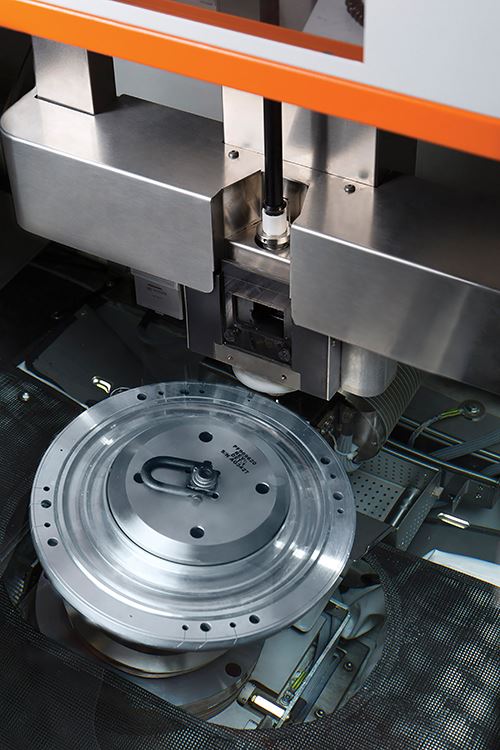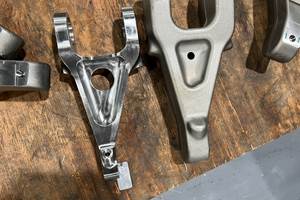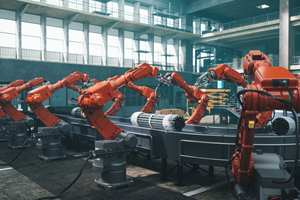Wire EDM for Jet Engine “Fir Trees”
Advances in wire EDM (electrical discharge machining) technology have made it acceptable for machining critical aerospace parts. It may now become the preferred method for cutting turbine disc “fir trees,” a particularly demanding application that highlights the benefits of this machining process.
Share




The geometry has a striking resemblance to a fir tree—a profile that seems to consist of a series of branches that grow narrower on each side, giving it the tapered look characteristic of an evergreen—hence, the common name for the shape of the slot on the turbine disc and the matching shape on the root of the turbine blade. The fit between the root and slot provides room for thermal expansion while still retaining the blade against centrifugal force as the disc rotates at high speed (10,000 rpm is typical).
Cutting the fir tree pattern on both the disc and the blade root has been a challenge for jet engine manufacturers. A modern jet engine may have as many as 40 or more turbine discs, each disc holding as few as two dozen or as many as 200 blades. Cutting the numerous fir-tree-patterned slots on the discs poses several difficulties. The fir tree geometry is complex; the dimensional tolerances can be compared to the diameter of a human hair; the workpiece material is very hard, but sensitive to damage; the surface finish must meet exacting specifications. With so many slots to produce for each disc, the manufacturing method must be effective and efficient. The productivity of this operation is a significant factor in the total cost of jet engine production.
Jet engine manufacturers have studied this operation closely for decades, always searching for a cutting process that improves quality yet reduces the cost and time of producing these fir-tree-patterned slots. Currently, one of the most promising methods involves wire EDM as an alternative to broaching, the conventional process generally employed for this operation. Wire EDM has attractive benefits. It is flexible, highly precise and economical, and it lends itself to automation. Most important, advances in wire EDM technology enable it to produce surface conditions with none of the characteristics that once made it questionable for aerospace applications.
However, turbine discs are larger and heavier than the workpieces typically produced on wire EDM equipment. Other aspects of their production require capabilities not normally encountered in most wire EDM applications. The power supply (or spark generator), for example, must provide the parameter settings that leave no heat-affected surface conditions on sensitive aerospace workpiece materials. In addition, the part-tracking and manufacturing traceability requirements imposed on all aerospace parts must be fulfilled.
A specially designed wire EDM system for cutting fir tree patterns in engine discs has been developed by GF Machining Solutions (Lincolnshire, Illinois). It is based on the AgieCharmilles Cut 200 wire EDM that has been re-engineered to accommodate an unusual tilting rotary table and provide for automation. Other features include in-process probing, customized power-generator settings and process monitoring/tracking software. Because the system is “dedicated” to aerospace disc production, this version has been designated as the Cut 200 Dedicated wire EDM.
A disc production cell consisting of several of these wire EDMs is being installed at a jet engine manufacturer’s facility in Canada and is expected to go online in the third quarter of this year. Other jet engine manufacturers are watching this installation closely and have expressed interest in similar systems. Although discs produced on this pioneering system in Canada may not be included in current jet engine designs until further evaluation is completed, preliminary testing has been entirely positive.
Although this dedicated system is targeted to aerospace, it is by no means exclusively intended for jet engine disc production, GF Machining Solutions says. The novel features of the design concept can be adapted to other applications in energy and power generation industry sectors. Even more broadly, the capabilities of this wire EDM system are representative of wire EDM’s potential as a problem-solving process not to be overlooked when tough-to-machine, tightly toleranced, complex workpieces are encountered.
Better Than Broaching?
As the aerospace industry continues to adopt tougher materials, advanced, custom-engineered wire EDM systems give manufacturers the alternative to conventional machining processes, such as broaching, for generating fir tree geometries. In fact, preliminary analyses have shown that the cost of the wire EDM process is approximately 40 percent less than broaching, while it is capable of maintaining similar productivity levels.
Broaching shears material and, in the process, can work-harden part surfaces, especially on today’s advanced aerospace materials. As the broaching tool advances through the workpiece, its teeth intensify the work-hardened condition encountered by the successive teeth. This effect may cause a broach tool to wear quickly. So instead of one broach imparting about 100 acceptable tree patterns, it might last for only 20. Broaching tools are expensive to replace. EDM, on the other hand, is cost-effective and can cut complex shapes in these challenging materials.
Plus, EDM provides the versatility to change over quickly to cut a new shape, whereas broaching requires, in most instances, between 9 months to a year to develop a completely new tool. Essentially, reprogramming the path of the wire in the CNC file enables a new configuration of the fir tree pattern to be cut. Although wire cutting each fir tree may have a considerably longer cycle time than that for a broaching operation (which is usually completed in one stroke of the broaching tool), a multiple-unit wire EDM system with the same capacity as the broaching machine is comparable in cost. In addition, the multiple-unit EDM system has the advantage of production reliability. Relying on one broaching machine entails that production comes to a complete stop if this machine is down for maintenance or repair. With multiple EDM units, a stoppage of one machine does not shut down the whole line.
Wire EDM has additional advantages over broaching, developers contend. For one, broaching tends to create a burr, a slight ridge of unwanted material that extends over the edge of the finished slot. This burr must be removed mechanically in a subsequent operation. Wire EDM does not leave a burr. For another, broaching results can be adversely affected by variations in the speed of the broaching stroke, the spacing of the teeth and the uniformity of tooth geometry. Although wire EDM faces its own set of process variables, its overall consistency has been shown to hold tighter dimensional tolerances compared to broaching in this application. This accuracy improves the positioning and orientation of inserted turbine blades, which contributes to greater efficiency in jet engine performance.
Broaching and wire EDM leave different textures on the surface of the finished slot. Broaching produces microscopic grooves in one direction; wire EDM produces microscopic peaks and valleys. Neither texture creates an apparent advantage. However, as discussed below, what is significant is the fact that the surface integrity of these diverse surface conditions is the same.
Proper Table Manners
The key design changes and features of the AgieCharmilles Dedicated wire EDM line include a new B/C tilting rotary table, in-process probing and the company’s e-Tracking software, as well as other software functionality. The new table system not only enhances the process of EDMing large, heavy aerospace parts, but it also enables the machine to be automated.
A major factor impacting the design of the new machine was the weight of these aerospace workpieces. It led to the development of an unconventional, non-trunnion style table: a C-axis rotary table with B-axis swivel. The unit rides in a horizontally oriented, crescent-shaped axis that provides a swaying motion to the right and left. The table enables the Cut 200 Dedicated to handle loads as heavy as 551.16 pounds (250 kg) without the risk of flexing, which can happen with conventional rotary/tilt tables. According to its developers, what differentiates the new design and gives it strength is that the table is built directly into the base of the machine.
In the past, designs typically located the A/B rotary table on top of a machine’s existing standard table. Unfortunately, workpieces would then sit high, requiring unusually tall Z-axis travel. And, because workpieces sat so high, the machine’s lower flushing nozzles were further away from the workzone, causing poor flushing conditions that reduced cutting speed and lowered accuracy.
For the new design, engineers removed the table of the standard AgieCharmilles Cut 200 wire EDM, bored out a cavity underneath the machine’s casting and installed the new-style table. This arrangement is said to eliminate issues with part weight and its affect on the table. Moreover, the design locates the tilting motion directly under the worktable clamping surface to enhance load support and promote accurate table motion.
Workpieces also sit lower in the machine, so the machine’s lower wire guide head is close to the workzone, thus improving flushing conditions. Moreover, tilting the workpiece while keeping the wire vertical means that the alignment of the upper and lower wire guide heads can be maintained, an arrangement that also improves flushing. The net effect of these improved flushing conditions is increased cutting speed and accuracy.
Ready For Automation
It has been difficult to automate the production of large jet engine parts on wire EDMs with standard A/B tables. Standard rotary-tilt tables occupy much of a machine’s work envelope and restrict a robot’s ability to load and unload parts. The table design of the AgieCharmilles Cut 200 Dedicated is intended to facilitate automation. For the same reason, designers relocated all power cables to the back of the work envelope to clear the workspace and eliminate interference. Likewise, the upper and lower guide heads are able to move out of the way to enable a robot to enter for loading and unloading parts without obstacles, and then move back into place during EDM operations.
Additionally, an in-process probe system automates part setups on the new machine. The system checks part flatness in the X and Y axes, the part’s height in the Z axis, the angle of the B axis, and whether the part is located on the center of the C axis. According to developers, gathering this probe data provides validation to the overall process. This information is logged within the e-Tracking system.
Generating Success
Perhaps the most significant aspect of this fir tree application is that it confirms the acceptability of wire EDMed workpieces in jet engine manufacturing. The generator functionality on the Agie-Charmilles Cut 200 Dedicated produces no detectable “white layer,” which the builder reports to be proven by research conducted by the jet engine manufacturer. This so-called white layer consists of microscopically thin sublayers of the workpiece material that may have been metallurgically changed by the highly localized but intense heat of the EDM process. The concern has been the possibility that this white layer can flake off, leading to microcracking and eventual part failure.
In general, the development of digital power generators has enabled wire EDM to mitigate the formation of this white layer. Digital technology provides precise and consistent control of the spark formation process. GF Machining Solutions says it has taken this capability to an optimal level for aerospace alloys such as titanium and Inconel. Essentially, this capability manages the heat involved in the EDM process by manipulating the parameters of the electrical discharge that creates each spark. In a nutshell, the intent is to produce a pulse of electrical energy that reaches the ideal temperature very rapidly, lasts long enough for material removal to occur, then “shuts off” before material melted away from the workpiece has time to resolidify on its surface. Instead, the material is quenched in the dielectric fluid and is washed away as hard particles with only a minimal chance to fuse onto the workpiece surface.
The cutting strategy applied to the fir tree patterns involves an initial roughing pass that severs a solid slug from the disc followed by three skim cuts. In each skim cut, the energized wire passes along but not in contact with the newly exposed surface of the workpiece. For each successive skim cut, spark parameters must be set so the electrical discharges selectively remove unwanted peaks left by the previous pass.
Properties of the EDM wire must also be precisely matched to this application. In this case, the wire specified is a brass wire double-coated with layers of zinc that is available only for the dedicated system. The brass core has the strength to withstand the delivery of energy intense enough to melt an aerospace alloy, while the zinc coatings are lost sacrificially to protect the wire and the workpiece. In the skim cuts, the coatings minimize the traces of brass from the wire’s core that may be retained on the EDMed workpiece surface. These traces have been found to be so slight that a mild acid cleaning process normally applied after EDMing is sufficient to remove them entirely.
Finally, it must be mentioned that the conductivity and temperature of the dielectric water supply must be monitored and closely maintained to achieve the optimal results intended.
Traceable and Trackable
The power generator parameters and the means to control them are proprietary to the developer. Also proprietary is the capability of the software in the processor of the power generator to record all of the process parameters and link them to each operation. This is the function of the e-Tracking feature included with the dedicated disc system. This software feature, an onboard data acquisition capability, is an option for the company’s machining solutions. It monitors each process in detail and ensures traceability, which is essential in aerospace work. The e-Tracking system also provides a real-time dashboard to monitor an entire shop, as well as machine and consumables status for preventative maintenance. The latest version of this system is compatible with the MTConnect interoperability standard.
The design concepts and technology developments represented by the Cut 200 Dedicated wire EDM do not restrict its application to jet engine turbine discs. GF Machining Solutions believes these developments will expand the use of wire EDM wherever workpieces of similar size, weight and complexity are encountered in tough workpiece materials. This includes many components of titanium and high-nickel alloys for energy and power generation. To expand the range of applications further, the company has incorporated the same concepts in a larger-model wire EDM, the AgieCharmilles Cut 300 Dedicated. This model is suitable for parts as largely at 3.6 feet (1.1 meter) in diameter and weighing as much as 1,322 pounds (600 kg).
To support these specialized wire machines for specific applications, the company provides fixture development services, automation integration and project engineering.
Related Content
5 Tips for Running a Profitable Aerospace Shop
Aerospace machining is a demanding and competitive sector of manufacturing, but this shop demonstrates five ways to find aerospace success.
Read MoreHorizontal High-Speed Machining Saves Hundreds of Work Hours
High-speed machining is the latest change at Blair-HSM South, helping this once old-fashioned shop improve productivity and morale while enabling new work.
Read MoreSolar Atmospheres Receives Northrop Grumman Approval for South Carolina Facility
All five Solar Atmospheres facilities are now an option for customers with Northrop Grumman requirements for vacuum heat treating.
Read MoreIncreasing OEM Visibility to Shopfloor Operations for the Win
A former employee of General Motors and Tesla talks about the issues that led to shutdowns on factory lines, and what small- to medium-sized manufacturers can do today to win business from large OEMs.
Read MoreRead Next
Building Out a Foundation for Student Machinists
Autodesk and Haas have teamed up to produce an introductory course for students that covers the basics of CAD, CAM and CNC while providing them with a portfolio part.
Read MoreSetting Up the Building Blocks for a Digital Factory
Woodward Inc. spent over a year developing an API to connect machines to its digital factory. Caron Engineering’s MiConnect has cut most of this process while also granting the shop greater access to machine information.
Read More5 Rules of Thumb for Buying CNC Machine Tools
Use these tips to carefully plan your machine tool purchases and to avoid regretting your decision later.
Read More




.jpg;width=860)




















.jpg;maxWidth=300;quality=90)









